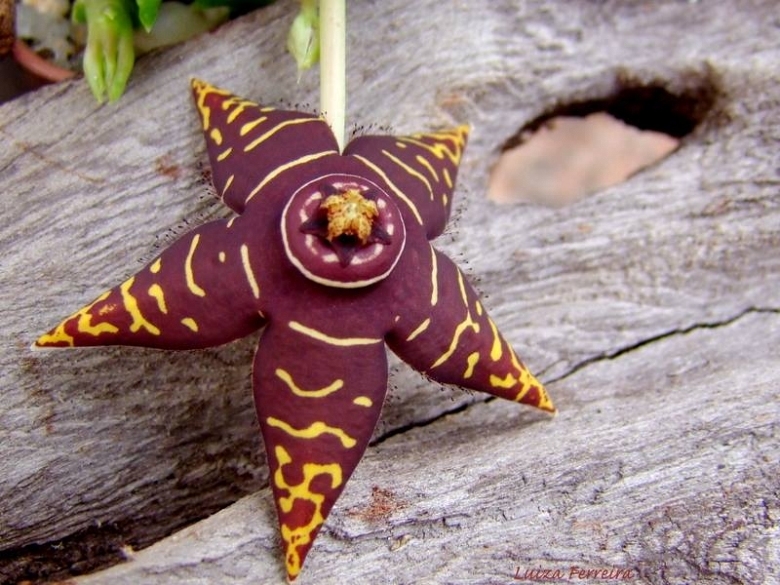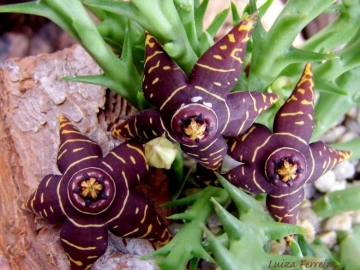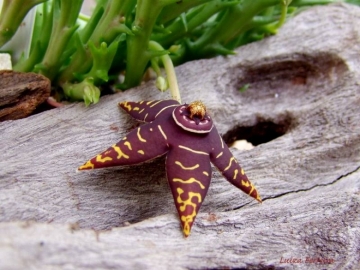




Your support is critical to our success.

Origin and Habitat: Orbea halipedicolaSN|30634]]SN|30634]] is endemic to the coastal region of the Sofala Province near the Buzi River, central Mozambique.
Altitude range: 20 - 200 metres above sea level.
Habitat and ecology: This species grows on almost bare flats close to slightly sodic pans and the sea, often in the shade of bushes in Mopane and Hyphaene dominated woodland.
Synonyms:
- Orbea halipedicola L.C.Leach
- Stapelia halipedicola (L.C.Leach) P.V.Heath
Orbea halipedicola L.C.Leach
Excelsa Taxon. Ser. 1: 40 1978
Synonymy: 3
- Orbea halipedicola L.C.Leach
- Stapelia halipedicola (L.C.Leach) P.V.Heath
- Orbea halipedicola subs. septentrionalis L.C.Leach
Description: Orbea halipedicolaSN|19768]]SN|30634]] is a leafless succulent perennial herb clustered or in cushions. Plants are attractive with prostrate, sometimes creeping stems often streaked with dark purple-brown on a pale ground colour when grown in good light, partially with subterranean runners. As with several of the tropical species of Orbea, they have long, slender, ascending tubercles that break up their outline and make them harder to see among tufts of grass. It produces beautiful star-shaped flowers, lying flat on the ground, these are purplish-brown on the inner surface with yellow to white markings.
Stems: Fleshy, slender, pale green, grey-green or olive-green and mottled or streaked with purple-maroon, up to 15(-20) cm long, c. 5 mm in diameter, simple or branched from the base, slender, sometimes creeping, decumbent to suberect, partly underground, 4-ribbed, sides furrowed, with widely spaced tapering tubercle teeth up to 10 mm long, differing from most orbeas in curving out-wards from the stem and then ascending parallel with the stem; denticles present.
Flowers: Arising in few-flowered inflorescences from near the base, and often pressed to the ground. Buds broadly ovoid-pentagonal, apically acute, basally truncate. Bracts 1.5-2 mm long, 1-1.5 mm wide, ovate, acute, concave. Pedicels 20-30 mm long, 2 mm in diameter, horizontally spreading. Sepals 5 -6 mm long, 2.5 mm wide, alternating with glands, these c. 2 mm long, subulate or filiform, fleshy. Corolla very shortly pubescent and smooth, 37-40 mm in diameter, flat. Corolla lobes spreading, fleshy 14-16 mm long, 9-10 mm wide, outside glabrous, along the middle partly furrowed, inside glabrous, very shortly pubescent, purple-brown or maroon striped or blotched, margins slightly revolute, cream to golden-yellow, ciliate with spoon-like, purple vibratile hairs c 2 mm long, and only slightly reflexed. Annulus flat rounded, depressed in the centre, sunken in the middle,15-25 mm in diameter, 1.5-2.5 mm hight, and sometimes with pale concentric rings. Corona raised yellowish-purple 6-6.5 mm in diameter, transversely rectangular, apically truncate, irregularly dentate, central margin distinctly raising, narrowly triangu-lar, apically with a fleshy appendage reaching be-yond the margin of the lobes, divaricate, slightly revolute. Outer corona inversely shallowly bowl-shaped, lobes 1.5 x 2 mm, dark purple-black. Inner corona-lobes 3.5 - 4 x ± 1 mm, golden-yellow with maroon-red markings, erect, apical appendage filiform, tip obtuse, slightly revolute, basally with 2 fleshy acute teeth, dorsally humped, much overtopping the Anthers, pointing inward occasionally meeting each other above the style head. Pollinia 0.6 x 0.6 mm, D-shaped.
Fruits (paired follicles): Slightly diverging, fusiform, acute, glabrous, smooth, densely streaked with dark purple-brown on a pale ground colour.
Similar species. Orbea halipedicolaSN|30311]]SN|30634]] is similar to Orbea umbraculaSN|30457]]SN|31263]] and Orbea woodiiSN|31263]]SN|30457]] in many espects. All of them have slender tubercles on the stems. There is also a relationship with Orbea semotaSN|30634]]SN|30311]], but that species has a more rugulose corolla and its stems more closely resemble those of Orbea variegataSN|30634]]SN|19768]].
Subspecies, varieties, forms and cultivars of plants belonging to the Orbea halipedicola group
 Orbea halipedicola L.C.Leach
Orbea halipedicola L.C.Leach- Orbea halipedicola subs. septentrionalis L.C.Leach: has shorter, thicker, more erect stems. Distribution: north of the Buzi River and common in the Gorongoza Park woodland.
Bibliography: Major references and further lectures
1) Focke Albers, Ulrich Meve “Illustrated Handbook of Succulent Plants: Asclepiadaceae: Asclepiadaceae” Volume 4 Springer Science & Business Media, 2002
2) Court, “Succulent flora of southern Africa”, A.A. Balkema, Rotterdam 1981
3) John Hunter Thomas “Systematic Botany Monographs” American Society of Plant Taxonomists, 2002
4) Hyde, M.A., Wursten, B.T., Ballings, P., Dondeyne, S. & Coates Palgrave, M. (2015). "Flora of Mozambique: Species information: Orbea halipedicola."
http://www.mozambiqueflora.com/speciesdata/species.php?species_id=185230, retrieved 26 February 2015
5) Bruyns, P.V. (2002). “Monograph of Orbea and Ballyanthus (Apocynaceae-Asclepiadoideae-Ceropegieae)” Systematic Botany Monographs 63 Pages 131 - 134. (Includes a picture).

Orbea halipedicola Photo by: Luiza Ferreira

Orbea halipedicola Photo by: Luiza Ferreira
Cultivation and Propagation: Orbea halipedicolaSN|30634]]SN|30634]] grow well in light gritty soil with a very liberal drainage. They should at all times sparingly watered (best rain water with some occasional fertiliser), and in winter time they hardly require any. They require outdoor culture, or a warm close greenhouse, while growing in the early part of summer, and afterwards may be ripened and kept in a greenhouse; but as they bloom chiefly in autumn, warmth is desirable to enable them to expand their flowers.
A minimum winter temperature of 5-10°C is acceptable, providing that plants are kept absolutely dry. They prefer light shade rather than full sun, although stems may not colour up under shady conditions.
Propagation: Plants are usually increased by cuttings, which, as they are very succulent, should be allowed to dry a week after they are taken off, when they may at once be put singly into pots.
Pest & diseases: Keep their roots free of mealy bugs, as fungal attack often occurs as a result of damage to stems by insects. A layer of grit on the surface of the compost prevents moisture from accumulating around the base of the stems and minimise the chance of fungal attack on the roots.
| Your Actions | |
|---|---|
| Back to Orbea index | |
| Back to Asclepiadaceae index | |
 |
Back to Succulents Encyclopedia index |
Privacy stantement - Terms and conditions - How to cite - About us - Feedback - Donate



